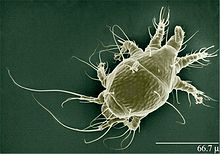Tarsonemidae
| Tarsonemidae | |
|---|---|

| |
| Acarapis woodi | |
| Scientific classification | |
| Domain: | Eukaryota |
| Kingdom: | Animalia |
| Phylum: | Arthropoda |
| Subphylum: | Chelicerata |
| Class: | Arachnida |
| Order: | Trombidiformes |
| (unranked): | Heterostigmatina |
| Superfamily: | Tarsonemoidea |
| Family: | Tarsonemidae Kramer, 1877 |
| Diversity | |
| 45 genera, > 500 species | |
Tarsonemidae is a family of mites, also called thread-footed mites or white mites.
Only a limited number of tarsonemid genera (
Taxonomy
Subdivision[2]
- Subfamily Pseudotarsonemoidinae
- Tribe Tarsonemellini
- Tribe Pseudotarsonemoidini
- Subfamily Acarapinae
- Tribe Coreitarsonemini
- Subfamily Tarsoneminae
- Tribe Hemitarsonemini
- Tribe Steneotarsonemini
- Tribe Tarsonemini
- Tribe Pseudacarapin
Selected genera
- Acarapis
- Floridotarsonemus
- Phytonemus
- Polyphagotarsonemus
- Steneotarsonemus
- Tarsonemus
Control
While little pest management research has been done on the majority of tarsonemid species, comprehensive studies have been made into the biological and chemical control of the cyclamen mite and the broad mite. Chemical trials demonstrated that
References
- ^ ISBN 978-0-520-02381-9.
- ^ JIANZHEN LIN & ZHI-QIANG ZHANG. Tarsonemidae of the World. 2002
- ^ G. Sterk; G. E. Bal; W. Goossens & D. Bylemans (1997). "Semi-field and field experience in the control of the strawberry mite, Tarsonemus pallidus (Banks) (Acarina: Tarsonemidae)". Parasitica. 53 (1): 25–33.
- ^ I. Nugroho & Y. Ibrahim (2004). "Laboratory bioassay of some entomopathogenic fungi against broad mite". Journal of Agricultural Biology. 6 (2): 223 225.
- .
- ^ P. G. Weintraub & E. Palevsky (2003). "Distribution and diel movement of the predatory mite, Neoseiulus cucumeris, on greenhouse sweet pepper – preliminary study". IOBC/WPRS Bulletin. 26: 89–94.
External links
- Joel Hallan's Biology Catalog: Tarsonemidae
- cyclamen mite, Phytonemus pallidus on the University of Florida / Institute of Food and Agricultural Sciences Featured Creatures website
- Dr. Eddie Ueckermann. TAXONOMY OF TARSONEMIDAE. ARC

